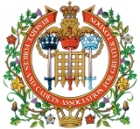

The partial reorganisation of the Territorial Army in 1984 called for an increase of 3 Infantry Battalions, one of which would be raised in London.
There were at that time four detached company strength units in London; G (London Scottish) Company of the Highland Volunteers, D (London Irish) Company of the Royal Ulster Rifles, C (City of London) Company 5th Battalion The Royal Regiment of Fusiliers (V) and B (Albuhera) Company 6/ 7th Battalion The Queen's Regiment (V). In addition, there were two Battalions entirely based within Greater London; 4th Battalion The Royal Green Jackets (V) and 10th Battalion The Parachute Regiment (V).
With the exception of 10th Battalion The Parachute Regiment, all the other units were asked to consider either raising a further Battalion or expanding to Battalion strength. All declined with the exception of the Royal Regiment of Fusiliers and the Queen's Regiment. Their TA companies were the last units representing their cap badges within the whole of Greater London. As both Regiments were in the Queen's Division it seemed logical that the best way to secure the foothold of both Regiments within Greater London was to pool resources and raise a Battalion that would be dual cap-badged.
Thus on 16th May 1984, Albuhera Day (a common Battle Honour between both Regiments) both B Company Badged Queen's Regiment and C Company Badged Royal Regiment of Fusiliers, marched into the newly refurbished TA Centre at 27 St John's Hill, Battersea and the Queen's Fusiliers were born.
The Role of the Battalion
Known to all as 8QF, the unit was designated as a Nuclear Artillery Security Battalion and as such one of only three TA Battalions with that role. The task was simply to protect the Missile Batteries of 50 Missile Regiment Royal Artillery should there be a confrontation with the forces of the Warsaw Pact.
50 Missile Regiment was stationed in Germany and in an emergency 8QF would provide a Defence Platoon for each battery and would be responsible to the Royal Artillery Battery Commander for the Defence of his Missile Units, both in transit or operational locations.
Battalion Locations in Greater London
In order to complete its 3 Rifle Company establishment, an additional company was raised at Camberwell in South London where a completely new Drill Hall had been built on the site of the old 1st Surrey Rifles Drill Hall, in Flodden Road. The Battalion locations were:
Unit Identity
Wearing the two cap badges of existing Regiments generally posed no real problems. A and B Company were badged entirely The Queen's Regiment and C Company remained Fusiliers. However, Headquarter Company would always of necessity be multi-cap badged and would have two sources of recruitment. Firstly, those who were posted in from The Rifle Companies and would keep their ‘company' cap badge, and secondly, those who joined Headquarters Company as recruits. The latter were issued their cap badge on the basis that every third recruit through the door would be badged Fusilier. However, the Battalion employed a degree of flexibility with this rule in that if for some reason a recruit asked particularly to be badged Queen's or Fusilier then, where possible, the request would be granted.
As 8QF progressed there was generally a comfortable feeling amongst most senior ranks accepting the twin Regimental identity. Nevertheless, the Battalion had earned the right to in some way to protect its own identity and there were at first low key proposals including 8QF stable belts, lanyards and shoulder slides of which only the latter came into being.
An application for the Battalion to be issued with Colours was refused by the Ministry of Defence on the grounds that it was unacceptable to have the Regimental badges of both the Queen's Regiment and the Royal Regiment of Fusiliers on a single Battalion colour.
In 1990, 8QF was honoured with the Freedom of the City of London.
Final Days
In 1992, with the collapse of the Soviet Union the threat from the Warsaw Pact receded to the extent that there was no longer a requirement for a Nuclear Artillery Defence Battalion, 8QF was in its entirety joined with G (London Scottish) Company of the Highland Volunteers and D (London Irish) Company of the Ulster Regiment to form the new London Regiment.
In its short four years existence, 8QF achieved success as an effective operational unit and in spite of what could have been a festering identity problem, the senior ranks, irrespective of cap badge, showed a determination to make their Battalion work, truly laying the foundations for the multi-cap badged London Regiment.
In spite of the disappointment of not receiving Colours, 8QF were honoured by the Freedom of the City of London and the right to wear the City Shield, which to this day are still proudly worn by C (City of London) Company and B (Queen's Regiment) of the London Regiment.
